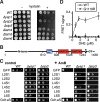A new family of StART domain proteins at membrane contact sites has a role in ER-PM sterol transport
- PMID: 26001273
- PMCID: PMC4463742
- DOI: 10.7554/eLife.07253
A new family of StART domain proteins at membrane contact sites has a role in ER-PM sterol transport
Abstract
Sterol traffic between the endoplasmic reticulum (ER) and plasma membrane (PM) is a fundamental cellular process that occurs by a poorly understood non-vesicular mechanism. We identified a novel, evolutionarily diverse family of ER membrane proteins with StART-like lipid transfer domains and studied them in yeast. StART-like domains from Ysp2p and its paralog Lam4p specifically bind sterols, and Ysp2p, Lam4p and their homologs Ysp1p and Sip3p target punctate ER-PM contact sites distinct from those occupied by known ER-PM tethers. The activity of Ysp2p, reflected in amphotericin-sensitivity assays, requires its second StART-like domain to be positioned so that it can reach across ER-PM contacts. Absence of Ysp2p, Ysp1p or Sip3p reduces the rate at which exogenously supplied sterols traffic from the PM to the ER. Our data suggest that these StART-like proteins act in trans to mediate a step in sterol exchange between the PM and ER.
Keywords: S. cerevisiae; StART protein; VASt domains; cell biology; cholesterol; ergosterol; lipid traffic; membrane contact sites; polyenes.
Conflict of interest statement
The authors declare that no competing interests exist.
Figures


















References
-
- Anderson TM, Clay MC, Cioffi AG, Diaz KA, Hisao GS, Tuttle MD, Nieuwkoop AJ, Comellas G, Maryum N, Wang S, Uno BE, Wildeman EL, Gonen T, Rienstra CM, Burke MD. Amphotericin forms an extramembranous and fungicidal sterol sponge. Nature Chemical Biology. 2014;10:400–406. doi: 10.1038/nchembio.1496. - DOI - PMC - PubMed
Publication types
MeSH terms
Substances
Grants and funding
LinkOut - more resources
Full Text Sources
Other Literature Sources
Molecular Biology Databases

